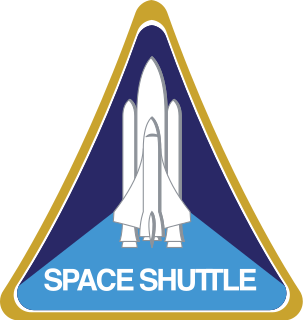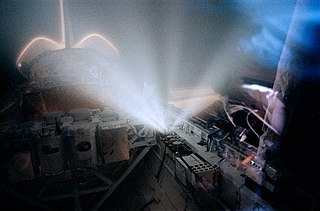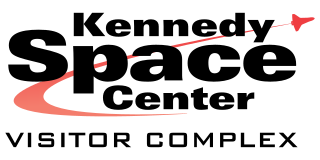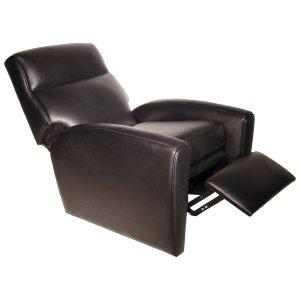
Apollo 9 was the third human spaceflight in NASA's Apollo program. Flown in low Earth orbit, it was the second crewed Apollo mission that the United States launched via a Saturn V rocket, and was the first flight of the full Apollo spacecraft: the command and service module (CSM) with the Lunar Module (LM). The mission was flown to qualify the LM for lunar orbit operations in preparation for the first Moon landing by demonstrating its descent and ascent propulsion systems, showing that its crew could fly it independently, then rendezvous and dock with the CSM again, as would be required for the first crewed lunar landing. Other objectives of the flight included firing the LM descent engine to propel the spacecraft stack as a backup mode, and use of the portable life support system backpack outside the LM cabin.

The John F. Kennedy Space Center, located on Merritt Island, Florida, is one of the National Aeronautics and Space Administration's (NASA) ten field centers. Since December 1968, KSC has been NASA's primary launch center of human spaceflight. Launch operations for the Apollo, Skylab and Space Shuttle programs were carried out from Kennedy Space Center Launch Complex 39 and managed by KSC. Located on the east coast of Florida, KSC is adjacent to Cape Canaveral Space Force Station (CCSFS). The management of the two entities work very closely together, share resources and operate facilities on each other's property.

A pointing device is a human interface device that allows a user to input spatial data to a computer. CAD systems and graphical user interfaces (GUI) allow the user to control and provide data to the computer using physical gestures by moving a hand-held mouse or similar device across the surface of the physical desktop and activating switches on the mouse. Movements of the pointing device are echoed on the screen by movements of the pointer and other visual changes. Common gestures are point and click and drag and drop.

The Space Shuttle program was the fourth human spaceflight program carried out by the U.S. National Aeronautics and Space Administration (NASA), which accomplished routine transportation for Earth-to-orbit crew and cargo from 1981 to 2011. Its official name, Space Transportation System (STS), was taken from a 1969 plan for a system of reusable spacecraft of which it was the only item funded for development.

A planetarium is a theatre built primarily for presenting educational and entertaining shows about astronomy and the night sky, or for training in celestial navigation.

Surveyor 3 was the third lander of the American uncrewed Surveyor program sent to explore the surface of the Moon in 1967. It was the first mission to carry a surface-soil sampling-scoop.

Clementine was a joint space project between the Ballistic Missile Defense Organization and NASA, launched on January 25, 1994. Its objective was to test sensors and spacecraft components in long-term exposure to space and to make scientific observations of both the Moon and the near-Earth asteroid 1620 Geographos.

Surveyor 1 was the first lunar soft-lander in the uncrewed Surveyor program of the National Aeronautics and Space Administration. This lunar soft-lander gathered data about the lunar surface that would be needed for the crewed Apollo Moon landings that began in 1969. The successful soft landing of Surveyor 1 on the Ocean of Storms was the first by an American space probe on any extraterrestrial body, occurring on the first attempt and just four months after the first Moon landing by the Soviet Union's Luna 9 probe.

The Apollo Lunar Module, or simply Lunar Module, originally designated the Lunar Excursion Module (LEM), was the Lunar lander spacecraft that was flown between lunar orbit and the Moon's surface during the United States' Apollo program. It was the first crewed spacecraft to operate exclusively in the airless vacuum of space, and remains the only crewed vehicle to land anywhere beyond Earth.

Orbiter is an open source space flight simulator program developed to simulate spaceflight using realistic Newtonian physics. The simulator was released on 27 November 2000; the latest edition, labeled "Orbiter 2016", was released on 30 August 2016, the first new version of the simulator since 2010.

STS-39 was the twelfth mission of the Space Shuttle Discovery. The primary purpose of the mission was to conduct a variety of payload experiments for the Department of Defense.

The Bell Aerosystems Lunar Landing Research Vehicle was a Project Apollo era program to build a simulator for the Moon landings. The LLRVs were used by the FRC, now known as the NASA Armstrong Flight Research Center, at Edwards Air Force Base, California, to study and analyze piloting techniques needed to fly and land the Apollo Lunar Module in the Moon's low gravity environment.

The Kennedy Space Center Visitor Complex is the visitor center at NASA's Kennedy Space Center on Merritt Island, Florida. It features exhibits and displays, historic spacecraft and memorabilia, shows, two IMAX theaters, and a range of bus tours of the spaceport. The "Space Shuttle Atlantis" exhibit contains the Atlantis orbiter and the Shuttle Launch Experience, a simulated ride into space. The center also provides astronaut training experiences, including a multi-axial chair and Mars Base simulator. The visitor complex also has daily presentations from a veteran NASA astronaut. A bus tour, included with admission, encompasses the separate Apollo/Saturn V Center. There were 1.7 million visitors to the visitor complex in 2016.

Space Camp is an educational camp in Huntsville, Alabama, on the grounds of the U.S. Space & Rocket Center museum at NASA's Marshall Space Flight Center. It provides residential and educational programs for children and adults on themes such as space exploration, aviation and robotics. The camp is run by a state government agency, the Alabama Space Science Exhibit Commission. More than 900,000 campers have graduated since 1982, including several who became astronauts.

A recliner is an armchair or sofa that reclines when the occupant lowers the chair's back and raises its front. It has a backrest that can be tilted back, and often a footrest that may be extended by means of a lever on the side of the chair, or may extend automatically when the back is reclined.

The Lunar Atmosphere and Dust Environment Explorer was a NASA lunar exploration and technology demonstration mission. It was launched on a Minotaur V rocket from the Mid-Atlantic Regional Spaceport on September 7, 2013. During its seven-month mission, LADEE orbited around the Moon's equator, using its instruments to study the lunar exosphere and dust in the Moon's vicinity. Instruments included a dust detector, neutral mass spectrometer, and ultraviolet-visible spectrometer, as well as a technology demonstration consisting of a laser communications terminal. The mission ended on April 18, 2014, when the spacecraft's controllers intentionally crashed LADEE into the far side of the Moon, which, later, was determined to be near the eastern rim of Sundman V crater.

The Minotaur V is an American expendable launch system derived from the Minotaur IV, itself a derivative of the LGM-118 Peacekeeper ICBM. It was developed by Orbital Sciences Corporation, and made its maiden flight on 7 September 2013 carrying the Lunar Atmosphere and Dust Environment Explorer spacecraft for NASA.

The Virginia Air and Space Science Center is a museum and educational facility in Hampton, Virginia that also serves as the visitors center for NASA's Langley Research Center and Langley Air Force Base. The museum also features an IMAX digital theater and offers summer aeronautic- and space-themed camps for children.

Astronaut training describes the complex process of preparing astronauts in regions around the world for their space missions before, during and after the flight, which includes medical tests, physical training, extra-vehicular activity (EVA) training, procedure training, rehabilitation process, as well as training on experiments they will accomplish during their stay in space.




















